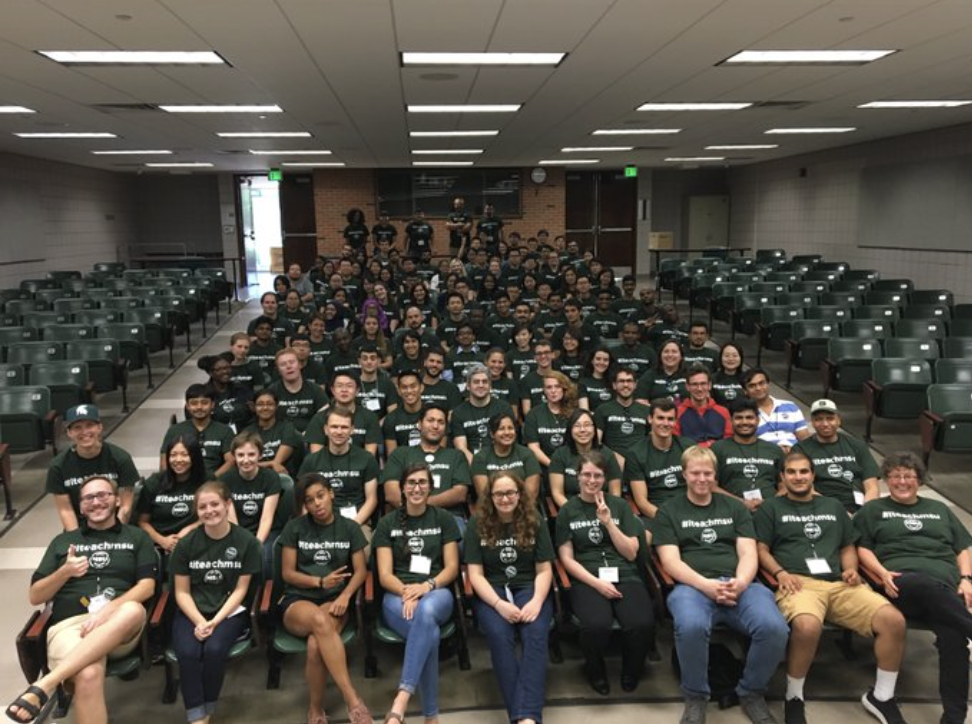We found 142 results that contain "with attachment"
Posted on: #iteachmsu


Posted by
over 4 years ago
Poor Listening Skills
Do you zone out during long business meetings? Did your husband forget to pick up your child at baseball practice, even though you called to remind him on his way home? Problems with attention result in poor listening skills in many adults with ADHD, leading to a lot of missed appointments and misunderstandings.
Do you zone out during long business meetings? Did your husband forget to pick up your child at baseball practice, even though you called to remind him on his way home? Problems with attention result in poor listening skills in many adults with ADHD, leading to a lot of missed appointments and misunderstandings.
Posted on: #iteachmsu



Posted by
over 4 years ago

Software-as-a-Service (SaaS) is a software licensing model in which access to the software is provided on a subscription basis, with the software being located on external servers rather than on servers located in-house. Software-as-a-Service is typically accessed through a web browser, with users logging into the system using a username and password.
Assessing Learning
Posted on: #iteachmsu


Posted by
over 4 years ago
How can educators identify and select accommodations to address the needs of individual students?
Using a set of guiding questions, the teacher will identify one response accommodation for a student with a disability based on his or her individual strengths and needs and the barrier created by the disability. The educator will then implement the accommodation and evaluate its effectiveness. Finally, the teacher and student will reflect on the effectiveness of the accommodation.
Beech, M. (2010). Accommodations: Assisting students with disabilities, 3rd Ed. Tallahassee, FL: Bureau of Exceptional Education and Student Services, Florida Department of Education. Retrieved from
http://www.fldoe.org/core/fileparse.php/7690/urlt/0070069-accomm-educator.pdf
Cortiella, C. (2005). No Child Left Behind: Determining appropriate assessment accommodations for students with disabilities. Retrieved from
http://mail.advocacyinstitute.org/resources/NCLDbriefsAccommodations.pdf
Reed, P., Bowser, G., & Korsten, J. (2002, 2004). How do you know it? How can you show it? Oshkosh: Wisconsin Assistive Technology Initiative. Retrieved from
https://dpi.wi.gov/sites/default/files/imce/sped/pdf/at-know-it-show-it.pdf
Using a set of guiding questions, the teacher will identify one response accommodation for a student with a disability based on his or her individual strengths and needs and the barrier created by the disability. The educator will then implement the accommodation and evaluate its effectiveness. Finally, the teacher and student will reflect on the effectiveness of the accommodation.
Beech, M. (2010). Accommodations: Assisting students with disabilities, 3rd Ed. Tallahassee, FL: Bureau of Exceptional Education and Student Services, Florida Department of Education. Retrieved from
http://www.fldoe.org/core/fileparse.php/7690/urlt/0070069-accomm-educator.pdf
Cortiella, C. (2005). No Child Left Behind: Determining appropriate assessment accommodations for students with disabilities. Retrieved from
http://mail.advocacyinstitute.org/resources/NCLDbriefsAccommodations.pdf
Reed, P., Bowser, G., & Korsten, J. (2002, 2004). How do you know it? How can you show it? Oshkosh: Wisconsin Assistive Technology Initiative. Retrieved from
https://dpi.wi.gov/sites/default/files/imce/sped/pdf/at-know-it-show-it.pdf
Assessing Learning
Posted on: #iteachmsu



Posted by
over 6 years ago

Globalisation and Education in the Postcolonial World:
Towards a conceptual framework The article examines the relevance of existing accounts of globalisation and education for low income, postcolonial countries, with special reference to the education systems of sub-Saharan Africa. Using recent developments in globalisation theory, existing accounts are analysed in relation to their view of the origins, nature and future trajectory of globalisation and the implications for education. It is argued that most of the recent literature deals with Western industrialised countries and the newly industrialised countries of the Pacific Rim and therefore has limited relevance for low income countries. The literature that is concerned with low income countries often lacks a firm theoretical basis and has been limited to a discussion of the impact of economic globalisation on education. Drawing on recent work on the political economy of development and the state in Africa, the article sets out a conceptual framework for understanding various aspects of the education/globalisation relationship in low income, postcolonial countries including economic, political and cultural aspects.
Towards a conceptual framework The article examines the relevance of existing accounts of globalisation and education for low income, postcolonial countries, with special reference to the education systems of sub-Saharan Africa. Using recent developments in globalisation theory, existing accounts are analysed in relation to their view of the origins, nature and future trajectory of globalisation and the implications for education. It is argued that most of the recent literature deals with Western industrialised countries and the newly industrialised countries of the Pacific Rim and therefore has limited relevance for low income countries. The literature that is concerned with low income countries often lacks a firm theoretical basis and has been limited to a discussion of the impact of economic globalisation on education. Drawing on recent work on the political economy of development and the state in Africa, the article sets out a conceptual framework for understanding various aspects of the education/globalisation relationship in low income, postcolonial countries including economic, political and cultural aspects.
Assessing Learning
Posted on: #iteachmsu



Posted by
over 4 years ago

Ask the student to submit a reflection about whether the accommodation helped with demonstrating knowledge. Whenever possible, we prefer to receive the student’s original work rather than a transcript or summary of the student’s reflection. The format of the reflection can accommodate the age or disability (e.g., written, audio) of the student. If, to meet this requirement, it is necessary to submit a transcript of a conversation with the student, please report the student’s responses verbatim.
Posted on: #iteachmsu



Posted by
over 1 year ago

2. Introduce Books, Storytelling And Narration -- Edited
Books play a vital role in both brain development and language skills. They’re also the first step towards gross motor skill development (holding books, turning pages). I had introduced cloth books & soft sponge books to her when she was two months old, board books from five months, and paper books after she turned a year old. She liked colourful objects, animals, birds & shapes till around nine months and then loved listening to simple short stories from illustrated books (no fairy tales). And activity books (match the shadows, pairing similar objects) after she turned 2.
3. Ask Questions To Stimulate The Thinking Process
As I introduced the books, I named the objects she was seeing in all the languages I knew. Then I gradually started describing them (shape, colour, use). I explained the environment in which they are found and constantly asked her questions. For example, pointing at a rabbit, instead of asking “what is this?” I asked her, “it has long ears, a short fluffy tail, is soft & white like cotton. What is it?”. I continued with the exercise even when we went out to some shop or mall. We played the “I spy” game in the house & outdoors. I would describe objects and ask her to identify them. It was fun.
4. Let Your Kids Explore - Touch, Feel, Smell, Taste
I encouraged the natural tendency that kids have to explore the world around them. (But of course, with discretion). I never stopped her from playing with stones or mud in the garden, things like tasting sour lime or bitter gourd, smell a flower on the plant, etc. She learned by herself that stones were hard, mud was soft, ice was cold, the paper could be torn with hands and rubber bands were elastic & so on. Things that were not safe for her we explained to her & kept out of reach- like touching a hot cup of tea could burn her skin, pressing against a glass door could break the glass, playing with a sharp object could hurt, etc.
5. Music-Dance-Physical Activity
Kids love music & I was not surprised the other day when she sang the whole song “lakdi ki kathi, kathi pe ghoda” and danced to the tune as well. She now sings quite a few songs & rhymes. It seems like she has a good ear for music because she has been listening to it since childhood. I also noticed that a soothing instrumental piece calms her down whereas a song like “lungi dance” excites her. So, dance becomes an excellent physical activity to channelise the never-ending energy of a kid, and singing & listening to songs becomes a great mental activity.
6. Building Event Memory, Associating Things & Situations
Kids these days use their smartphones very dexterously, and photos are their favourite part. Although I have limited her total gadget time (phone, iPad, TV) to 30-45 minutes, I make good use of the photos she sees to build her event memory. Whenever she sees some old photos, I describe to her the event. I tell her who all were present, which places we had visited, etc. After several repetitions, this activity has helped her build a memory of past events. She also recognises people from the photos even if she meets them after a long time. She has learned to associate certain things with specific events like lanterns with Diwali or Santa Claus with Christmas.
7. Independence
It was okay if she initially spilt a little food or water on the table, but she learned to hold her spoon & cup. It took a lot of time to wear shoes, most of the time, she put them on the wrong feet, but now she wears them perfectly. Kids figure out things themselves, and we need not tell them how to do it. We need to give them some time. I am happy my child eats independently, combs her hair, brushes her teeth, & wears her shoes. I always encouraged her to do these simple activities even if they were time-consuming initially and she couldn’t do them at all.
8. Age-Appropriate Toys, Art, And Craft
Use age-appropriate toys like building blocks, push & go toys, insert shapes in slots for gross motor skills development. Some simple paper-folding art, glueing stickers on papers, colouring can also help refine motor skills.
9. Logical Reasoning & Decision Making
Kids think logically, and we just have to encourage this to stimulate their brain activity and enhance their thinking process. I always try to reason things for her (wherever possible). And she has developed the same habit. I make her choose between two things at times- simple things like which dress she wants to put on or which game she wants to play- the decision-making is a good brain stimulator.
10. The Most Important - Excellent Nutrition
Good food is a key to good development and a good mood as well. A healthy body nurtures a healthy mind. Fortunately, my daughter is not a picky eater but there are days when she gives me a hard time.
A balanced nutritious diet is essential. Vegetables, seasonal fruits, eggs, pulses are all building blocks for a proper diet. Milk with #Junior Horlicks is also a great choice as it includes nutrients that support brain development, such as choline, iron, and iodine. It also contains nutrients that support physical growth, such as calcium, Vitamin D, Vitamin K, and proteins, and also nutrients to support healthy immune function such as Vitamin E, A, Selenium & Copper. You can design a wholesome diet with roti, rice, whole-grain bread, wheat pasta, curd, cheese and maybe a scoop of ice cream and some sweets once in a while.
Books play a vital role in both brain development and language skills. They’re also the first step towards gross motor skill development (holding books, turning pages). I had introduced cloth books & soft sponge books to her when she was two months old, board books from five months, and paper books after she turned a year old. She liked colourful objects, animals, birds & shapes till around nine months and then loved listening to simple short stories from illustrated books (no fairy tales). And activity books (match the shadows, pairing similar objects) after she turned 2.
3. Ask Questions To Stimulate The Thinking Process
As I introduced the books, I named the objects she was seeing in all the languages I knew. Then I gradually started describing them (shape, colour, use). I explained the environment in which they are found and constantly asked her questions. For example, pointing at a rabbit, instead of asking “what is this?” I asked her, “it has long ears, a short fluffy tail, is soft & white like cotton. What is it?”. I continued with the exercise even when we went out to some shop or mall. We played the “I spy” game in the house & outdoors. I would describe objects and ask her to identify them. It was fun.
4. Let Your Kids Explore - Touch, Feel, Smell, Taste
I encouraged the natural tendency that kids have to explore the world around them. (But of course, with discretion). I never stopped her from playing with stones or mud in the garden, things like tasting sour lime or bitter gourd, smell a flower on the plant, etc. She learned by herself that stones were hard, mud was soft, ice was cold, the paper could be torn with hands and rubber bands were elastic & so on. Things that were not safe for her we explained to her & kept out of reach- like touching a hot cup of tea could burn her skin, pressing against a glass door could break the glass, playing with a sharp object could hurt, etc.
5. Music-Dance-Physical Activity
Kids love music & I was not surprised the other day when she sang the whole song “lakdi ki kathi, kathi pe ghoda” and danced to the tune as well. She now sings quite a few songs & rhymes. It seems like she has a good ear for music because she has been listening to it since childhood. I also noticed that a soothing instrumental piece calms her down whereas a song like “lungi dance” excites her. So, dance becomes an excellent physical activity to channelise the never-ending energy of a kid, and singing & listening to songs becomes a great mental activity.
6. Building Event Memory, Associating Things & Situations
Kids these days use their smartphones very dexterously, and photos are their favourite part. Although I have limited her total gadget time (phone, iPad, TV) to 30-45 minutes, I make good use of the photos she sees to build her event memory. Whenever she sees some old photos, I describe to her the event. I tell her who all were present, which places we had visited, etc. After several repetitions, this activity has helped her build a memory of past events. She also recognises people from the photos even if she meets them after a long time. She has learned to associate certain things with specific events like lanterns with Diwali or Santa Claus with Christmas.
7. Independence
It was okay if she initially spilt a little food or water on the table, but she learned to hold her spoon & cup. It took a lot of time to wear shoes, most of the time, she put them on the wrong feet, but now she wears them perfectly. Kids figure out things themselves, and we need not tell them how to do it. We need to give them some time. I am happy my child eats independently, combs her hair, brushes her teeth, & wears her shoes. I always encouraged her to do these simple activities even if they were time-consuming initially and she couldn’t do them at all.
8. Age-Appropriate Toys, Art, And Craft
Use age-appropriate toys like building blocks, push & go toys, insert shapes in slots for gross motor skills development. Some simple paper-folding art, glueing stickers on papers, colouring can also help refine motor skills.
9. Logical Reasoning & Decision Making
Kids think logically, and we just have to encourage this to stimulate their brain activity and enhance their thinking process. I always try to reason things for her (wherever possible). And she has developed the same habit. I make her choose between two things at times- simple things like which dress she wants to put on or which game she wants to play- the decision-making is a good brain stimulator.
10. The Most Important - Excellent Nutrition
Good food is a key to good development and a good mood as well. A healthy body nurtures a healthy mind. Fortunately, my daughter is not a picky eater but there are days when she gives me a hard time.
A balanced nutritious diet is essential. Vegetables, seasonal fruits, eggs, pulses are all building blocks for a proper diet. Milk with #Junior Horlicks is also a great choice as it includes nutrients that support brain development, such as choline, iron, and iodine. It also contains nutrients that support physical growth, such as calcium, Vitamin D, Vitamin K, and proteins, and also nutrients to support healthy immune function such as Vitamin E, A, Selenium & Copper. You can design a wholesome diet with roti, rice, whole-grain bread, wheat pasta, curd, cheese and maybe a scoop of ice cream and some sweets once in a while.
Disciplinary Content
Posted on: #iteachmsu



Posted by
about 2 months ago

o be easily distracted,
o have difficulty following directions,
o frequently lose materials, and/or
o have difficulty organizing tasks and materials.
Predominantly hyperactive/impulsive type.
The student may:
o Appear to be in constant motion,
o frequently fidget or move in his or her seat,
o become restless during quiet activities,
o leave his or her seat when expected to remain seated,
o interrupt others and classroom activities,
o talk excessively, and/or
o fail to follow classroom procedures (e.g., blurt out answers without raising hand).
Combined type.
The student may exhibit symptoms that include behaviors from both categories above.
In order for a student to be diagnosed with ADHD, symptoms must appear before age 12 and be exhibited across at least two settings. They must also have adverse effects on academic performance, occupational success, or social-emotional development (APA, 2013).
To add to the complexity of the diagnosis, children with ADHD are likely to have co-existing emotional, behavioral, developmental, learning, or physical conditions (Wolraich & DuPaul, 2010).
As a result of the behaviors listed above, students with ADHD are at greater risk of academic
difficulties, social/emotional issues, and limited educational outcomes.
o have difficulty following directions,
o frequently lose materials, and/or
o have difficulty organizing tasks and materials.
Predominantly hyperactive/impulsive type.
The student may:
o Appear to be in constant motion,
o frequently fidget or move in his or her seat,
o become restless during quiet activities,
o leave his or her seat when expected to remain seated,
o interrupt others and classroom activities,
o talk excessively, and/or
o fail to follow classroom procedures (e.g., blurt out answers without raising hand).
Combined type.
The student may exhibit symptoms that include behaviors from both categories above.
In order for a student to be diagnosed with ADHD, symptoms must appear before age 12 and be exhibited across at least two settings. They must also have adverse effects on academic performance, occupational success, or social-emotional development (APA, 2013).
To add to the complexity of the diagnosis, children with ADHD are likely to have co-existing emotional, behavioral, developmental, learning, or physical conditions (Wolraich & DuPaul, 2010).
As a result of the behaviors listed above, students with ADHD are at greater risk of academic
difficulties, social/emotional issues, and limited educational outcomes.
Disciplinary Content
Posted on: #iteachmsu



Posted by
over 4 years ago

Possible sequences include:
Beginning with an essential question and moving from general ideas to the specific mechanics of the text. This is a particularly effective way to drive engagement.
Beginning with a close reading and later expanding to broader ideas in the text. This is helpful for unpacking dense, complex texts or when the learning objective emphasizes close reading.
Toggling between establishing meaning in the text and analysis in order to support students’ comprehension while engaging in higher-order learning.
Beginning with an essential question and moving from general ideas to the specific mechanics of the text. This is a particularly effective way to drive engagement.
Beginning with a close reading and later expanding to broader ideas in the text. This is helpful for unpacking dense, complex texts or when the learning objective emphasizes close reading.
Toggling between establishing meaning in the text and analysis in order to support students’ comprehension while engaging in higher-order learning.
Disciplinary Content
